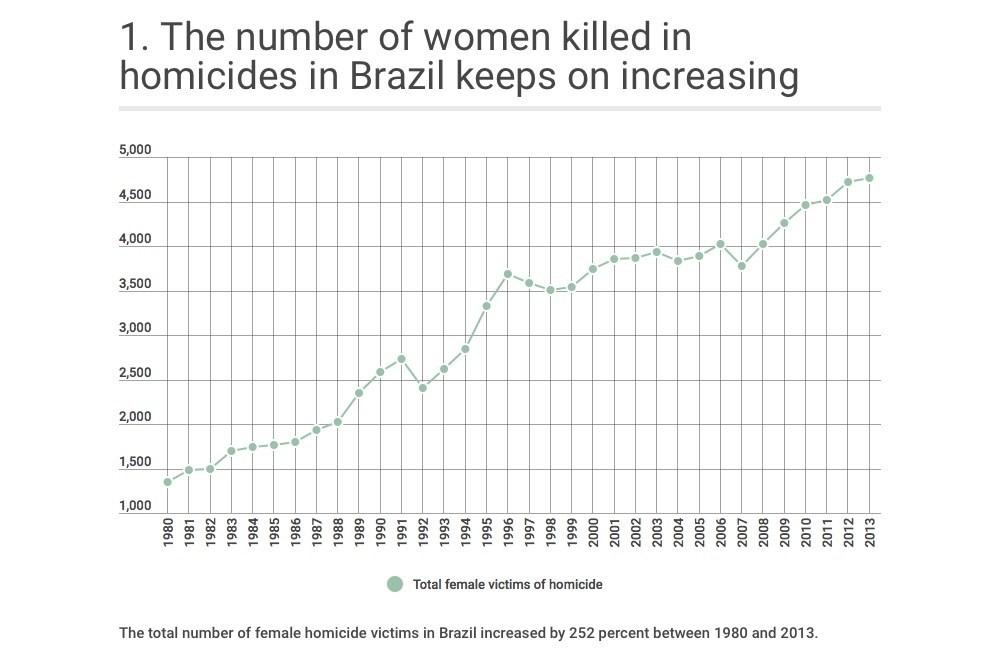The Rise of Femicide in Brazil: International Women’s Day 2019
Brazil has the highest rate of femicide in Latin America. According to the United Nations Economic Commission for Latin America and the Caribbean (ECLAC), around 40% of gender-based homicides in Central and South America occur within its borders.
Since January 1st, an average of four women were murdered every day because of their gender, with 67 failed attempts between the beginning of the year and the release of The Inter-American Commission on Human Rights’ (IACHR) press release in early February 2019. The IACHR described the rate of gender-based killings in Brazil as ‘alarming’ and of ‘deep concern’.
In 2017, the last year for which public data is available, 4,539 women were killed in Brazil, a rise of 6.1% on the previous year. Police recorded 1,133 of those murders as femicide however the actual number is likely higher due to authorities not registering killings as femicide if the crime is unsolved or the motive is initially unclear. Under Brazilian Law, femicide is defined as the killing of a woman “on account of being persons of the female sex.”
Media reports state that an average of 300 women every year are killed in the State of Rio de Janeiro.
A selection of femicide related incidents in Rio de Janeiro reported by Intelligence Fusion since January 1st 2019.
And in the state of São Paulo, 377 women were murdered between January and November 2018.
A selection of femicide related incidents in Sao Paulo reported by Intelligence Fusion since January 1st 2019.
Almost half of femicide incidents in Brazil are as a result of firearms, most of which are carried out in their own homes and by a family member or loved one. So it’s no surprise that the insecurity of women across the country spiked in January 2019 when Jair Bolsonaro, Brazil’s president, signed a decree that loosened gun ownership rules and allowed anyone without a criminal record to keep up to four guns at home.
It is widely thought that the relaxed gun laws will increase the risk of femicide and has been described as a ‘gateway to violence’. Since the announcement, victims of domestic violence have started a hashtag, #SeEleEstivesseArmado (“If he had been armed”), to share their stories and belief that if their abuser had access to a firearm, they would have been murdered.
A little more than a week later, a protest took place in front of the National Congress in Brasilia. A group of plus size models organised the event to urge women to report gender based violence and highlight the increasing rate of femicide across the country.
A femicide related murder and the reporting of the recent protest in Brasilia from January 2019.
Despite this, however, in the report released by the IACHR, the commission states that in most cases of femicide, the victims had already previously denounced their abusers. Their concern is that despite authorities being aware of a history of domestic violence or even, in some extreme cases, a prior homicide attempt from aggressors, not enough is being done to protect these women.
But this protest could be the beginning. With female homicides increasing year on year in Brazil, human and women’s rights activists believe it’s only a matter of time before we see a a public outcry demanding a change in societal roles of women in the country and the ‘deep-rooted machismo’ is addressed.
In 2015, the female population of Argentina started a worldwide media storm when one tweet sparked a 200,000 strong protest outside the Capitol building in Buenos Aires. This public demonstration, along with hundreds of smaller protests across the country, led to both the Supreme Court and the Human Rights Secretariat announcing new task forces that would begin collecting data on violence against women.
Marcela Ojeda’s tweet that sparked worldwide outrage against the violence of women in Argentina. “I sent that tweet in a fit of rage” Marcela said, after spending every day as a journalist interviewing the families of women who were victims of femicide.
Since the first protest in Argentina, the Ni Una Menos (Not One Less) movement grew stronger with marches spreading to Mexico, El Salvador, Bolivia, Chile, Paraguay, and Uruguay. It eventually saw the government re-examining how current laws are implemented in order to ensure tougher penalties for perpetrators and to protect victims of gender-based violence.
However, activists are aware that their biggest challenge is shifting the cultural attitudes embedded in countries like Brazil in order to sustain long-term change. They claim there is still much to be done in order to alter the ‘progressive ideology surrounding women in society’ throughout Latin America.
Protests and demonstrations continue across the region to raise awareness of the ongoing issue of femicide in South and Central America. Each year, International Women’s Day, sees an increase in marches across the world, one of the largest being the Movimiento Coordinadora 8M march in Buenos Aires.
International Women’s Day 2019 will be celebrated on Friday 8th March and this year, the Movimiento Coordinadora 8M is expanding, with a protest being conducted at the Plaza de Armas in Los Angeles, Chile. There are also planned protests in Mexico.
A tweet from @IFNorthAmerica reporting the planned demonstration for International Women’s Day 2019 in Tijuana, Mexico.
Intelligence Fusion is monitoring the growing femicide crisis in Latin America and will continue to report on the activism that aims to raise awareness and initiate change as well as analyse the wider impact on social and political unrest across the region.
For more information on our reporting and how we help organisations make informed, strategic decisions to protect their people, assets and reputations during periods of significant unrest, book your free demo today.


